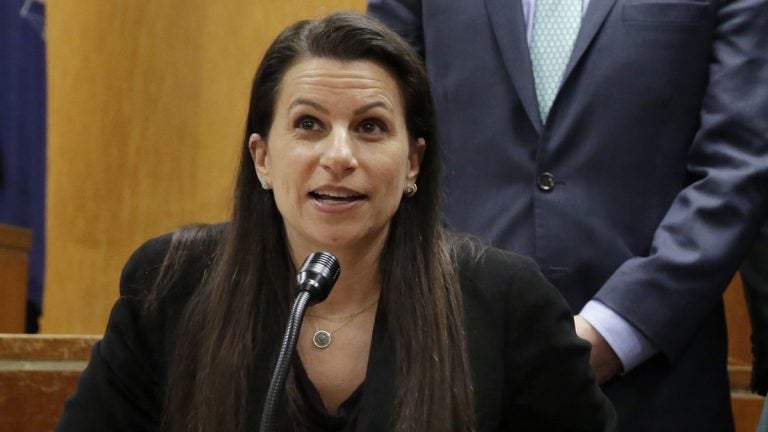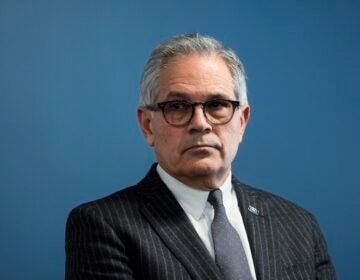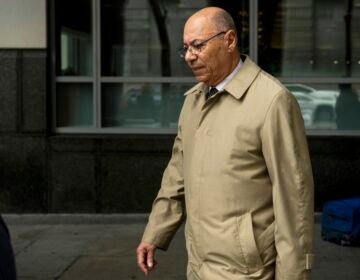Manhattan DA’s policies offer glimpse of how Krasner might shape Philly office
Philadelphia's new DA promises an emphasis on leniency and providing options other than incarceration to low-level offenders. That seems to be working out in Manhattan.
Listen 4:15
Assistant District Attorney Karen Friedman Agnifilo is the No. 2 prosecutor in the office of Manhattan District Attorney Cyrus Vance Jr. (AP Photo/Richard Drew)
After a convincing win Tuesday, civil rights lawyer Larry Krasner will be sworn in as Philadelphia’s district attorney in January.
He is promising major changes in the way the office charges and resolves crimes, with an emphasis on leniency, rather than harsh punishment, and providing options other than incarceration to low-level offenders.
Among the district attorney offices that have interested Krasner is Manhattan’s, where Cy Vance Jr. became the top prosecutor in 2010 after a campaign that included calls for ending the death penalty.
Well before Vance took heat for deciding not to pursue criminal charges against Harvey Weinstein and President Donald Trump’s children, his office was laboring to significantly drive down the number of arrests in Manhattan — especially for quality-of-life crimes, such as jumping subway turnstiles, which Vance said he would no longer prosecute.
Vance, along with three prosecutors from other New York bureaus, in August threw out en masse hundreds of thousands of bench warrants connected to decade-old unpaid civil citations.
He also has won plaudits for his “intelligence-driven prosecutions,” which gather data including a defendant’s background, life experience, community and what is driving crime in the person’s particular neighborhood in formulating charges and sentence recommendation.
WHYY’s Bobby Allyn talked to Karen Friedman Agnifilo, the No. 2 prosecutor in Vance’s office, about instituting unpopular changes, getting buy-in from rank-and-file prosecutors and what advice she has for Krasner as he begins to grapple with remaking an office recently plagued with controversy.
Note: The interview has been edited for clarity and brevity.
Bobby Allyn: What were some lessons learned by the office after Vance was elected in 2010 and began to launch new initiatives?
Karen Friedman Agnifilo: It was important for us to understand what the problems were in our communities and what our communities wanted from a prosecutor’s office. So we used data to get hold of both what are the crime problems in various areas, and we spoke with police officers and the community and the assistant DAs about who are the actors in each community responsible for crime. That allowed us to understand how much work we were doing in areas where we didn’t have to use the prosecution hammer, because, as the phrase goes, when the only tool you have is a hammer, everything looks like a nail.
We saw how many cases were being prosecuted that were low-level, nonviolent offenders. Many people who had no real reason to have the consequence of the criminal justice system. Getting hold of the data gave us an opportunity to follow the breadcrumbs and understand what the issues were. And it has worked.
There were 41 murders last year in Manhattan, which has a daytime population of 2.5 million people. That’s about a 50 percent drop from when he took office. And a far cry from the crime wave of the 1970s when there were more than 600 murders a year. We went from 100,000 cases a year being prosecuted and we’re working to cut that in half, too.
BA: Finding consensus among the 300 assistant district attorneys in Philadelphia’s district attorney’s office will be no small task. There have been rumors of some line prosecutors quitting with Krasner coming in, afraid that his values will clash too drastically with those of a line prosecutor, many who view victim advocacy as a priority. And, as Krasner’s opponent Beth Grossman has been quick to point out, Krasner did not underscore representing victims of crime in his campaign, which irritated some of the office’s rank and file, who will soon have Krasner as their boss. How do you get the more traditional, law-and-order prosecutors on board with progressive reforms?
KFA: I came up as a line prosecutor, so I understand the perspective that they come from, and we did not come up with the policies to no longer charge theft of services or dismiss all the bench warrants out of thin air. Those were policies we came up with after looking at the data and seeing that so many were needlessly arrested because they had summons warrants.
These are warrants for things like putting both their feet up on the subway or drinking beer in public. Same thing with turnstile jumpers. We realized it wasn’t our role to be a collections agency for the subway system.
Instead of prosecuting these crimes, we thought, why not try to divert them and help them with whatever is going on in their life that caused the arrest to begin with. To get line prosecutors to buy in, we just showed them the data we saw. Once you look at it, it’s clear what you should do. When you take the time to show them and go over the process, you can win over their hearts and minds, and they become your partners, not your adversaries.
BA: Can you talk more about the huge number of civil summonses that were dismissed?
KFA: When we looked at why so many people were getting arrested for crimes they were eligible to get a civil summons for – these were low-level offenses where police have a lot of discretion – it was because they had open bench warrants for violations or summonses (an unpaid citation). We thought that’s crazy. Many are 10 or more years old. No human police office is going to remember it from that long ago. They’re unprovable anyway. If that’s what is making someone go through the system, it makes no sense.
The whole city agreed. DA offices in Brooklyn, Queens and the Bronx also purged thousands of them. In Manhattan alone, Cy Vance stood up and moved to dismiss 240,000 summons warrants. These were individuals who stayed out of trouble for 10 or more years. So, we thought, they deserved amnesty at this point. Not to mention the immigration consequences of getting arrested. It can make you known to federal immigration officials, and then, maybe, they would get deported.
BA: How long did it take Vance to really get some of his policy goals off the ground?
KFA: Reform does not come easy. I often liken it to moving an aircraft carrier. And it’s not so easy to come up with an idea and then implement it by fiat. You need to take the time to figure out what the issues are and get buy-in.
It took us six months to even get a handle on the data in the office. We didn’t know what we had. And we didn’t know what we didn’t know. We didn’t know how many cases we had. We didn’t know where the crime was. We didn’t know what type of case we had. We didn’t know what kind of cases were getting dismissed and which ones were not getting prosecuted.
Then we brought in the Vera Institute to take another look at the data and layer on it a racial-disparity analysis.
BA: The New York Times described Vance’s “Moneyball” approach to crime in a long profile that highlighted the balance of tough-on-crime polices with a recognition that the criminal justice system is inherently biased against black and Hispanic offenders. Vance calls this the “intelligence-driven prosecution.” Can you talk more about that?
KFA: It’s important to look at who the person is and not just what they did. You can have two people charged with the same crime, and you might have a different outcome for each of them. You might have someone arrested for drug dealing — and they’re a drug addict and it might make more sense to send them to drug treatment, rather than prison. You might have another person arrested for drug dealing who is the head of a gang responsible for violence in any given community, and you might go much harder on that person because of who he is, not just what he did.
Everything should have a safety and criminal justice lens. If it helps public safety, then you prosecute them. But if you can change their life, you should do that. We want to help people get out of the situation that led to them getting arrested.
BA: What are some big-picture takeaways you can share from working under Vance the past seven years?
KFA: You can reduce your criminal justice footprint and still make crime go down, and that is something we have learned. And I think the No. 1 way of doing that is by doing targeted prosecution and targeted enforcement. It’s really important to know who the people in your community are who are responsible for most of the violent crime.
At the same time, you can help other individuals who come through your door who need help. The criminal justice system can be a gateway for them, whether it’s through a social worker or a mental health treatment or drug treatment or financial counseling. That’s as opposed to a door that closed you in and locks you up. We have made a concerted effort to only recommend incarceration for people who need to be incapacitated because they pose a public safety risk.
WHYY is your source for fact-based, in-depth journalism and information. As a nonprofit organization, we rely on financial support from readers like you. Please give today.




